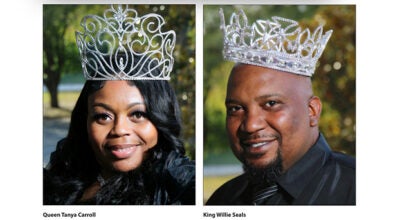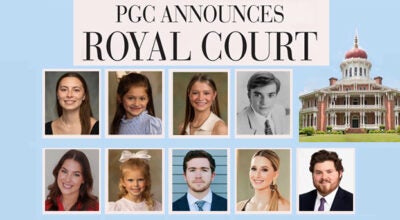Natchez man has been on the air since 1941
Published 12:07 am Sunday, January 19, 2014

George Adams makes a call from his Natchez house over his radio. While serving in the U.S. Navy Adams worked with radios because of his knowledge of Morse code.
Sometimes the sounds of Tommie Adams cooking breakfast go out to the world.
Many mornings, when she goes into the kitchen and looks through a window into the den area of her house, her husband George will be talking to a friend — or at least a likeminded hobbyist — somewhere in the country.
Tommie will say hello, but otherwise go about her business.
But George’s conversations aren’t over the telephone or the Internet. His words are running up a 100-foot tower and broadcasting across the airwaves at 20 megacycles, and the sounds of Tommie frying eggs can be heard by anybody who has a HAM radio.
George has been an amateur radio broadcaster since August 1941, using the same license and station identification — “This is Double-U Five Kilo Hotel Bravo W5KHB out of Natchez, Mississippi at 35 megahertz” — since before World War II ended.

To broadcast from his home in Natchez, Adams has a 100-foot tall antenna in his backyard. For more than 50 years Adams has broadcasted over ham radio and talked with people from all over the world.
Amateur radio enthusiasts don’t usually use the airwaves for broadcasting music, but instead use the electronic ether to communicate with other radio operators around the world. Even though new technologies have come along that enable such conversations without needing radio equipment, George said thousands still keep up the FCC-regulated hobby.
His own interest began after high school, when he started working for a radio repair business. With a FCC license in hand, George took to the airwaves with a hand-built, 10-watt transmitter sending Morse code he learned from a fellow ham operator out of Olathe, Kan.
“What did I build that radio with? Junk!” he said. “I used junk radios and junk tubes, and for an antennae we put on a piece of wire, 150-feet long, hung it 75 feet in the air.”
Those initial days of sending and receiving Morse code weren’t long lived. On Dec. 7, 1941 — better known as Pearl Harbor Day — the FCC shut down all amateur broadcasting.
“They didn’t want us going on the air and saying, ‘This so-and-so is from this place or another, but really he is a German,’” George said.
Following the outbreak of the war, George joined the Navy, and what had once just been his hobby suddenly was an asset for Uncle Sam. The Navy put him to work receiving Morse code for hours a day.
“The Navy wanted me to do that for them, because you might say I was a good buddy for them, coming in already trained,” he said.
After the war, George returned to Natchez and resumed his radio use as a hobby, though he would eventually start Adams Communication Service, a Motorola radio support business.
Getting started with the hobby a second time, George built a seven-foot-tall transmitter using more quality parts than his post-high school project, a transmitter he still has today and that still works, though he doesn’t use it anymore.
And with that transmitter, a tower and a radio microphone, George was able to talk to the world. People in London, Australia, on the high seas were all game to talk to the man broadcasting from his home in Natchez.
“I had one fellow who had several boats, and I think I talked to him in every ocean,” George said. “I caught him in Panama, outside of Europe and in the Pacific.”
The airwave conversations were able to take his voice to every continent, even Antarctica, where the researchers at the South Pole station offered their own simple observations about the environment around them.
Imitating a shivering man, George said, “They said, ‘Oh, we’re cold, it’s 100 degrees below zero here.’”
Occasionally, the radio would give him a brush with movers and shakers, as it did when he established contact with Barry Goldwater, the five-term senator and one-time Republican nominee for president.
“He was on at the same time I was, so I just talked to him,” George said.
In the 1950s, the hobby came to be of service again, this time not to Uncle Sam but to Natchez. An ice storm had crippled the area, and communication lines out of town were down. George and other ham operators in the area banded together to call in for simple supplies to be brought in — things like candles and shirts — and served as the line of communication for the railroad in Southwest Mississippi. The railroad company later presented him with a medal for the effort.
These days, George uses a transmitter he bought in 1991 and a 100-foot tower an oilfield client gave him when they decided to scrap it, but the routine is the same. Log on by stating the station identification number, and wait to see if anybody is listening and wants to talk.
Through the years, Tommie was there to hear the conversations, though she wasn’t much of a ham operator herself.
“I’m just an XYL,” she said, laughing. “A young married lady.”
XYL is one of many ham abbreviations, George said, where “OT” means “old timer,” “ND” means “nothing doing” and ‘73’ means ‘best regards.’
“We have our own set of abbreviations, just like the highway patrol, that other people might not recognize.”
But for anyone who has the equipment, knows the code and hears an OT log on in Natchez while his XYL is making breakfast in the background, sending a 73 might be worth it.
There are plenty of stories to be heard and conversations to be had at W5KHB.





